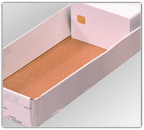Card recycling has yet to take off
 Recycling can provide a selling point for cards, but reclaimed plastic often comes in less-than-pure shades of white that can drive away card-industry decision makers.
Recycling can provide a selling point for cards, but reclaimed plastic often comes in less-than-pure shades of white that can drive away card-industry decision makers.
“The biggest concern among card manufacturers is being able to offer a consistent color,” says T.R. Mitchell, vice president of New Wave Plastics, a Medina, Ohio-based recycler.
To overcome the problem of impure whites tinged with yellow or gray, New Wave is working with Bolatron Performance Products, a Newcomerstown, Ohio-based sheet manufacturer that supplies the card manufacturers with print stock.
“Through this partnership, we have developed a program where we offer 80,000 pounds of consistent loads so we don’t have the problems of discoloration with recycled cards,” says Mitchell.
Yet skepticism of recycling remains. “It definitely makes the whites look ugly,” says Bill Crawford, vice president of sales and marketing for Franklin, Ohio-based Waytek Corp., a materials and coatings supplier to card manufacturers, and a board member of the Princeton Junction, N.J.-based International Card Manufacturers Association.
“Everybody likes to print on gorgeous virgin white stock and when you start to use recycled PVC in your stock it will look gray and streaky,” Crawford maintains. “Are you OK with your logo on streaky gray stock?”
Off-white card stock also can change the shades of the colors printed upon it, thus changing the look of company logos, says Shane Cunningham, marketing communications manager for Digital Identification Solutions LLC, which provides printers and software for creating secure credentials.
Other than color, recycled polyvinyl chloride–or PVC for short–performs almost exactly the same as virgin PVC in card manufacturing and processing, industry executives agree.
Recycled PVC has yet to establish a significant share of the market but could increase in popularity as consumers become more environmentally conscious. “We have been training society to recycle for many years,” notes Mitchell.
Crawford acknowledges that recycling could provide a selling point in some markets, such as gift cards, and suggests that marketers could capitalize on the discoloration as a mark of recycling authenticity. “There are some specialty applications where green is important and looks are not,” he says.
In such cases, a company marketing department could justify the expense of recycled PVC, which costs more than virgin PVC, Crawford says. Even when demand exists for cards made of recycled plastic, recycling the cards themselves might not make sense, according to Crawford. Driving two blocks to recycle a card would cause greater environmental harm than throwing away the card, he says.
Still, some are finding ways to make recycling the cards pay off. “We have set up a few programs with different manufacturers, where they will send cards to us and we will reprocess them and send them back,” Mitchell says. “However, the cards cannot be intermingled; they must be 100% PVC to do this.”
Crawford suggests the alternative of making cards from PVC used to make plumbing pipes or house siding. The use of PVC in building materials far outstrips the amount of PVC used in cards, he says.
In fact, he questions the need to recycle cards because of their relatively small amount of PVC. “The card industry use of PVC is insignificant compared to the packaging industry, the construction plastic–those markets are huge compared to the small amount of plastic you’re carrying in your wallet,” says Crawford.
Cunningham says his company has not received any requests for recycled PVC. He calls cards of recycled PVC “more of a PR thing than anything else.”



